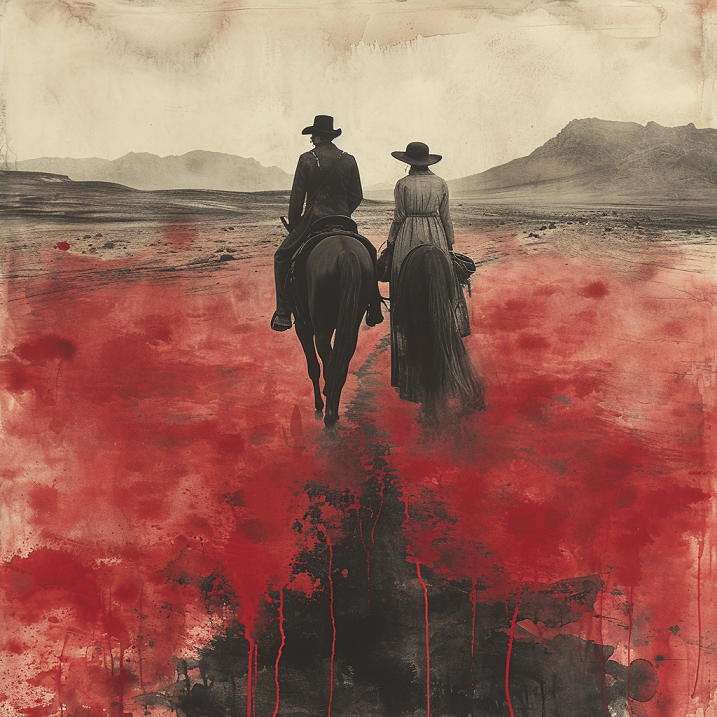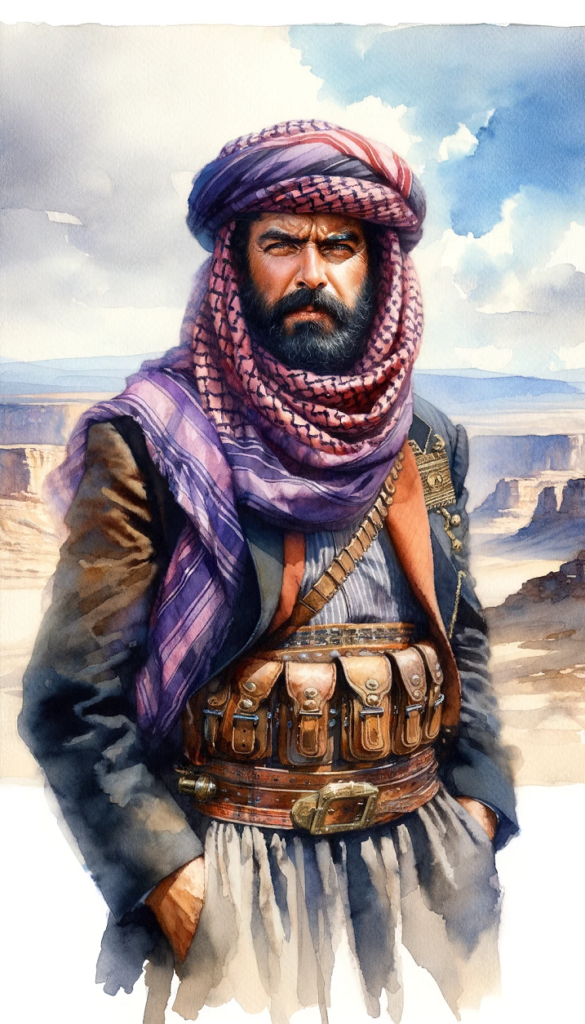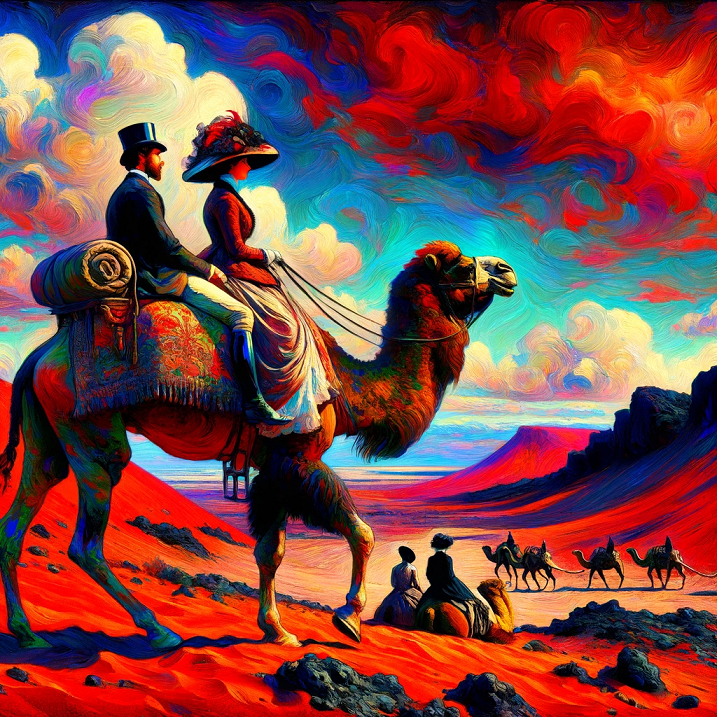“A Pilgrimage To Nejd” by Lady Anne Blunt stands as a captivating account of her journey through the Arabian Peninsula in the mid-19th century. This book is a rich tapestry woven with the threads of cultural encounters, geographical explorations, and the socio-political dynamics of a region little known to the Western world at that time. Lady Blunt, with her keen observations and eloquent descriptions, offers an invaluable glimpse into the life, customs, and landscapes of Arabia, far removed from the Orientalist narratives prevalent during her era.
Key Points:
- Lady Anne Blunt’s journey reveals the rich diversity of the Arabian Peninsula’s cultures and landscapes.
- Blunt’s interactions with various tribes showcase the complex tribal dynamics and diplomacy in the region.
- The hospitality of local tribes and communities is a recurring and significant theme in her travels.
- Environmental challenges, like water scarcity and murrain, profoundly impact local livelihoods.
- Lady Blunt’s account is a valuable historical document, offering insights into the 19th-century Arabian Levant.
Cultural Interactions and Observations
In her journey, Lady Anne Blunt offers an intricate mosaic of cultural encounters, presenting a vivid picture of the diverse groups inhabiting the Sham & Arabian Peninsula. Her narrative is replete with detailed descriptions of the people she meets, encompassing their attire, customs, and lifestyles. This rich tapestry of human diversity is most evident in her interactions with groups like the Druzes and Bedouins, as well as the local villagers.
A notable encounter is with Huseyn el-Atrash, a Druze sheikh, who exemplifies the dignity and grace of his people. Lady Blunt describes him as a man of about forty, extremely dark and handsome, his eyes made more brilliant by being painted with kohl. His attire, comprising a jibbeh and abba and a kefiyeh of purple and gold, reflects the cultural distinctiveness of the Druses. The sheikh’s hospitality and the ensuing conversation, careful to avoid prying into Lady Blunt’s purpose and identity, are testaments to the refined social customs prevalent among the Druses.
Similarly, her interaction with Sheikh Hassan in the village of Ghizeh, situated in modern day Jordan, reveals another facet of Arabian hospitality. Sheikh Hassan’s discreet and respectful hospitality, offering everything from coffee to water for the mares, portrays a culture deeply rooted in generosity and respect for guests. Unlike her fellow English successor Gertrude Bell, who took great interest in exploring the archeological sites of Jordan, Lady Blunt was a woman on a mission to procure horses and only casually remarked on objects of archaeological significance as she passed them.
Before leaving Ghizeh we went to. look at a house where there is a mosaic floor of old Roman work, scrolls with orange trees and pomegranates, vines with grapes on them, vases and baskets, all coloured on a white ground. It speaks well for the quality of the workmanship that it has so long stood the weather and the wear, for it is out of doors, and forms the pavement in the courtyard of a house.
Lady Anne Blunt: A Pilgrimage to Nejd, The Cradle of the Arab Race
Geographical Exploration and Description
Lady Anne Blunt’s narrative is as much about the landscapes she traverses as it is about the people she encounters. Her descriptions of the Arabian Peninsula’s geography are vivid and evocative, painting a picture of a land of stark contrasts. Through her eyes, we see the rich red soils of the Hauran, a region spanning Southern Syria and northern Jordan today, ready for cultivation, juxtaposed against the barren expanses of the desert.
The journey takes her through remarkable locations such as Salkhad, with its picturesque town hanging beneath an old fortress on a steep slope. The town, built with black volcanic stone, exudes a sense of ancient grandeur, its houses resembling a honeycomb structure. In contrast, Melakh presents a different aspect of medieval architecture, with its walls and towers leaning out of the perpendicular, crafted from the same black stone.
Lady Blunt’s account provides insights into how the geography directly influences the local lifestyle. For instance, the well-inhabited country with its numerous villages and rich soil speaks of a land that, despite its aridity, is capable of supporting agriculture and sustaining life. Yet, the challenges posed by the landscape are ever-present. She notes the scarcity of water in Hauran, where villages are dependent on rain for their water supply, highlighting the precarious balance between human endeavour and the whims of nature.
Political and Social Dynamics of the Region
Lady Anne Blunt’s journey through Jordan also sheds light on the complex political and social dynamics of the region during the mid-19th century. Her observations provide a nuanced understanding of the interplay between traditional tribal authorities and the overarching influence of the Turkish Ottoman Empire.
A significant aspect of this dynamic is the autonomy and independence exhibited by local tribes, in contrast to the areas under direct Turkish administration. For instance, in places like Salkhad and Melakh, Lady Blunt notes a sense of prosperity and well-being, possibly attributed to the limited reach of the Ottoman rule. This is juxtaposed against the backdrop of Turkish authority, which she perceives as less conducive to the welfare of the local populations.
Blunt also touches upon historical events that have shaped the region, such as the disturbances in Lebanon in 1860. These events had repercussions far beyond their immediate locales, affecting the demographic and political landscapes of neighbouring regions. For instance, the presence of Druses in Salkhad, a community believed to have been relocated from Lebanon following these disturbances, highlights the interconnectedness of regional events.
Moreover, Lady Blunt’s account gives insight into the impact of Midhat Pasha’s rule on the Druse communities. The shift from native Sheikhs to Ottoman governance signifies a pivotal change in the region’s political fabric, one that was met with resistance and had lasting implications for the local populace.
Challenges and Logistics of Desert Travel
In her chronicles, Lady Anne Blunt vividly portrays the challenges and intricacies of travelling through the Arabian desert in the 19th century. Her journey is marked by a series of logistical hurdles and the constant need to navigate through a landscape that is as unforgiving as it is beautiful.
One of the most significant challenges she describes is the navigation through various tribal territories. Each tribe, with its own set of rules and attitudes towards outsiders, presents a unique challenge. The need to understand and respect these tribal boundaries and customs is crucial for safe passage. Lady Blunt’s narrative often reflects the tension and caution inherent in crossing these unseen but deeply respected lines.
The principal difficulty is that there are several Bedouin tribes on the road, and nobody knows which. The Sirdieh are friends of Huseyn’s, and so are the Kreysheh, but there are others whom he does not know, Sherarat Sirhan and Howeysin, the last mere thieves ” worse than the Sleb.” Any or all of these may be met with, though it is very possible we may meet nobody.
Lady Anne Blunt: A Pilgrimage to Nejd, The Cradle of the Arab Race
The composition and dynamics of the caravan itself are central to the travel experience. Lady Blunt details the changes in the caravan’s composition, such as the departure of Abd er-Rahman and the recruitment of new members including a Shammari and a camel driver. These changes are not merely logistical; they reflect the fluid nature of travel in the desert, where adaptation and flexibility are essential for survival.
The physical act of travel, laden with the unpredictability of the desert terrain and the harshness of the climate, further adds to the challenges. Lady Blunt recounts the difficulties of navigating rocky paths, the constant threat of banditry, and the ever-present scarcity of water.
Journey Through Hauran
Lady Anne Blunt’s passage through Hauran stands out as a significant segment of her journey, marked by rich agricultural landscapes and the stark realities of rural life in the Arabian Levant. Her descriptions of Hauran bring to life a region that contrasts sharply with the barren expanses of the desert.
As she travels through this well-inhabited land, Lady Blunt notes the abundance of villages dotting the countryside. The rich red soil of the area, already ploughed and awaiting rain, speaks volumes about the agricultural potential of the region. This observation highlights the dependence of local agriculture on the unpredictable patterns of rainfall, a critical factor in the life and economy of the area.

However, the journey through Hauran is not without its challenges. Lady Blunt poignantly describes the aftermath of a contagion that devastated local livestock. The sight of dead cattle, a severe blow to the villagers’ livelihood, underscores the fragility of rural life in the face of natural calamities. Each working cow or bullock lost represented a significant economic setback for the villagers, as she notes their value and the impact of the loss on the community.
In all the numerous villages we saw the effects of the late murrain in the dead cattle strewed about. I counted seventy carcasses in one small place, a terrible loss for the poor villagers, as each working cow or bullock was worth ten pounds. I asked what disease had killed them, and was told it was ” min Allah ” (from God).
Lady Anne Blunt: A Pilgrimage to Nejd, The Cradle of the Arab Race
The scarcity of water in Hauran is another critical issue that Lady Blunt encounters. The reliance of villages on rain for their water supply, coupled with the dry state of the ancient reservoirs, paints a picture of a community struggling against environmental challenges. This struggle is further emphasized by her account of Sheikh Hassan’s village in Ghizeh, which is on the brink of a water crisis, demonstrating the harsh realities faced by these communities.
The Sheykh has been spending the evening with us. He is in great distress about his village, which is in the last straits for water. The cattle, as I have said, have all died, and now even the beasts of burden which have to go for the water are dying. The nearest spring is at Bozra, twelve miles off; and if the donkeys break down the village must die too of thirst. He told us that a Frank passed this way two years ago, and had told him that there must be an ancient well somewhere among the ruins of which the village is built, and he has been looking for it ever since.
Lady Anne Blunt: A Pilgrimage to Nejd, The Cradle of the Arab Race
Through her journey in Hauran, Lady Blunt not only captures the beauty and potential of the land but also brings attention to the environmental and economic challenges that define rural life in the Arabian Peninsula. Her narrative provides a nuanced understanding of the region, going beyond the mere description of landscapes to delve into the lives and struggles of its inhabitants.
Hospitality in Ghizeh and Melakh
Lady Anne Blunt’s journey that unfolds in two villages en route, Ghizeh and Melakh is replete with instances of remarkable hospitality and vivid portrayals of life in these towns. Her narrative shines a light on the cultural richness and social norms of the Levant, as seen through the lens of her experiences in these locations.
In Ghizeh, the hospitality of Sheikh Hassan stands out as a poignant example of the generous spirit inherent in Arabian culture. Lady Blunt describes the Sheikh’s warm welcome, offering not just food and coffee but also the much-needed water for both the travellers and their animals. This act of hospitality, offered by the host in a time of drought, reflects a deep-seated cultural tradition of graciousness towards guests, a trait that Lady Blunt frequently encounters in her travels.

Moving to Melakh, the encounter with Huseyn el-Atrash, a Druze sheikh, further exemplifies the region’s hospitable nature. Lady Blunt describes Huseyn as a “fine specimen of a Druse sheikh”, noting his distinguished appearance and attire. The sheikh’s welcome is marked by a sense of ceremony yet warmth, as he engages in polite conversation without prying into the travellers’ intentions. The hospitality extends to a sumptuous dinner, showcasing the local cuisine and the community’s ability to offer the best of what they have to their guests.
The Sheykh’s manners were excellent, very ceremonious but not cold, and though we conversed for an hour about ” the weather and the crops,” he carefully avoided asking questions as to who we were and what we wanted. Neither did we say anything, as Ave knew that the proper moment had not come. At last our camels arrived, and dinner was served, a most excellent one, chicken and burghul, horseradishes in vinegar and water, several sweet dishes, one a purée of rice, spiced tea, cream cheese, and the best water-melon ever tasted.
Lady Anne Blunt: A Pilgrimage to Nejd, The Cradle of the Arab Race
Lady Blunt’s experiences in these towns also provide a window into the everyday life and customs of their inhabitants. She observes the dynamics within Huseyn’s family, the interactions between different community members, and the simplicity yet richness of their lifestyle. These observations paint a picture of a society deeply rooted in tradition, where social customs and familial ties play a central role.
FAQs:
Q: What does Lady Anne Blunt’s journey reveal about the Arabian Peninsula?
A: It highlights the cultural diversity, geographical landscapes, and complex tribal dynamics of the region.
Q: How does the narrative depict the challenges of desert travel?
A: It shows the importance of local knowledge and the difficulties posed by the terrain and tribal territories.
Q: What does the book say about the political situation in the Arabian Peninsula during Blunt’s travels?
A: It illustrates the influence of the Ottoman Empire and the autonomy of local tribes.
Q: How is the theme of hospitality portrayed in Blunt’s travels?
A: Hospitality is a significant theme, showcased through generous and respectful interactions with local tribes and communities.
Q: What impact do environmental challenges have on the regions Blunt visited?
A: Environmental issues like water scarcity and livestock diseases significantly affect the livelihoods of local communities.
Q: What is the historical significance of Lady Anne Blunt’s account?
A: It provides valuable insights into the socio-political and cultural landscape of the 19th-century Arabian Peninsula.

